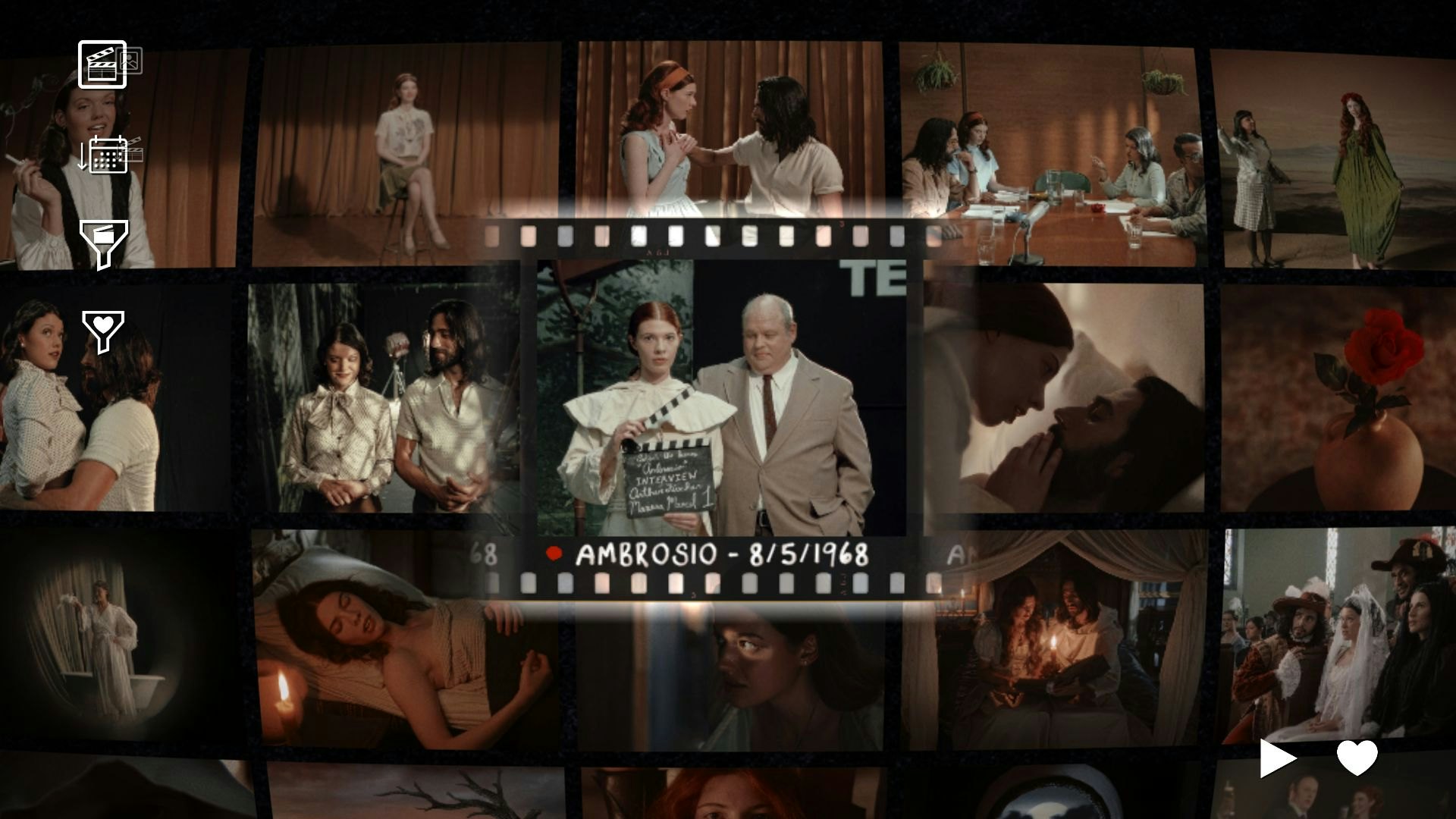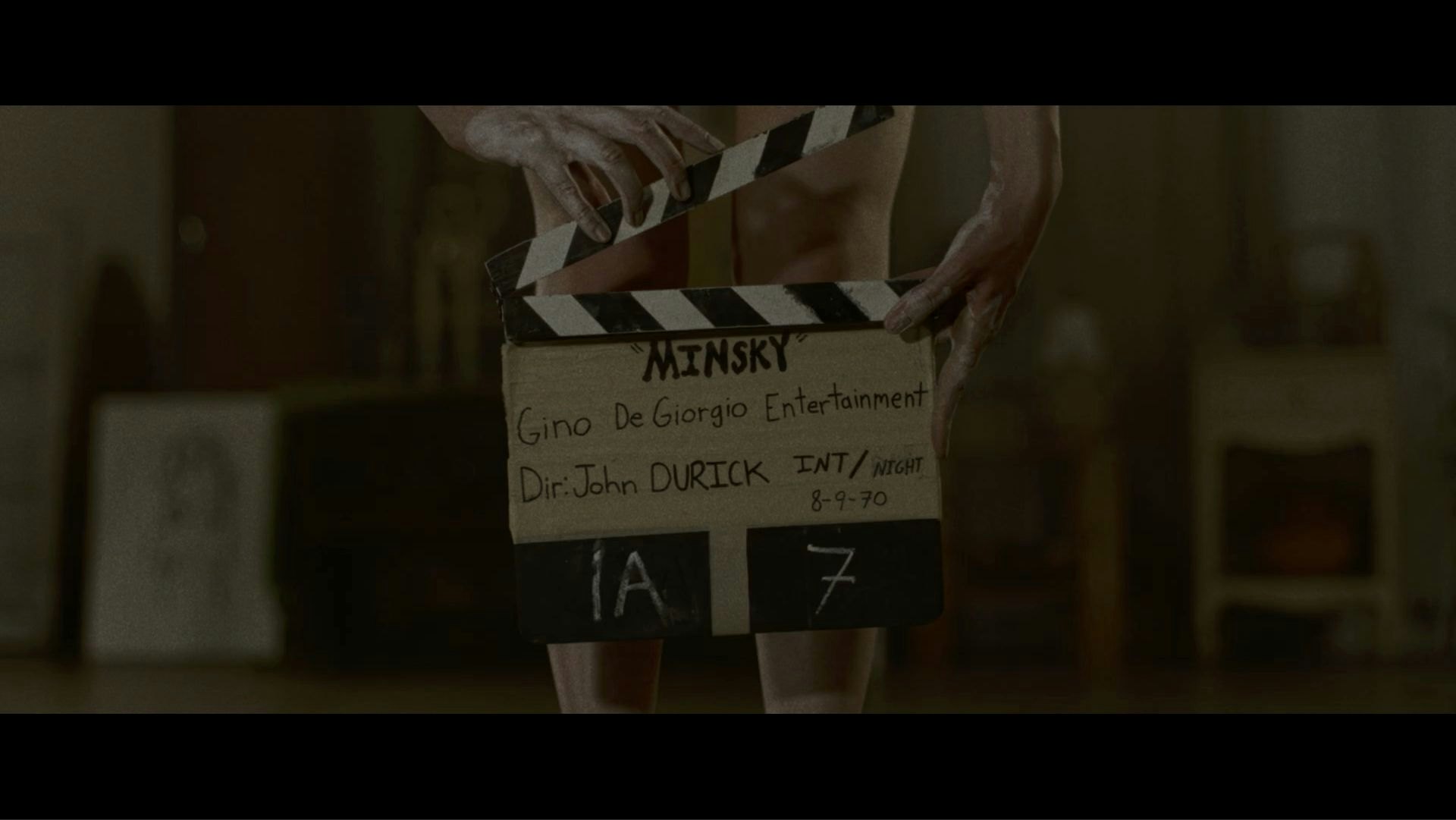
At 24 frames per second, a roll of film contains more individual images than the human eye can differentiate when it flicks past.
While repeatedly flicking backward and forward through a single clip of film in search of answers about the forgotten film star Marissa Marcel, I catch a glimpse of something: A phantom in the film roll. Was it even there before? Is it a trick of the light, passing through the film so quickly that I see movement? Or am I losing my mind … just a little bit?
Immortality, the latest full-motion video (FMV) game from developer Half Mermaid, unravels its mysteries like a film reel. Steeped in cinematic production and artistic language, the game tells a story about art, the people who make it, the people who consume it, and why any of us participate in the enterprise at all. Immortality is the antithesis of the belief that games are an art form, as its lofty attempts to establish prestige are built upon the language of another medium entirely (cinema). It relies on the spectacle of the project alone and not the substance, leaving an empty shell confident in but not convinced of its own self-importance.

Cut, Print, Move On
Marissa Marcel should have been a film star. She made three movies between 1968 and 1999, but none of them were ever released. Then Marissa Marcel disappeared. With several decades worth of archival footage from the three films, behind-the-scenes documentaries, and promotional material at your fingertips, Immortality asks the player to answer the question “What happened to Marissa Marcel?”
Her Story and Telling lies, from the same developers, also asked players to sift through hundreds of clips to uncover some mystery through the use of keywords that would link footage together. Rather than a game of words, Immortality is a game about images. Each clip can be scrubbed back and forth ad nauseam, and you can let your obsession stretch out over dozens of hours.
Mechanically, it recreates the experience of old Moviola editing machines, attempting to immerse the player in the cinematic fantasy. A knowing glance, the brush of a hand against a bare neck, a line delivery that feels a little too real; all of these can be what leads you down a rabbit hole of footage. To encourage this obsession, Half Mermaid provides the “Match Cut” feature. Stopping a clip at any point allows the player to focus on an object and be taken immediately to a “matching” scene in another random clip. Think 2001: A Space Odyssey’s cut from a thrown bone to a space station to separate the film’s first two parts.

Focusing on a prominent shot of a bouquet of roses can bring you to a clip with random flowers in the background. This mechanic leads to endless spiraling into some thread you choose to pull on. It is easy to forget you can come up for air. You can go as deep as you want, and you can roll credits but every player’s path through the footage will take a different route and last a different amount of time. I rolled credits after 5 hours.
Jumping from clip to clip can lead to massive revelations about Marissa Marcel’s career in connection with auteur filmmaker John Durik. The perfect combination of finding a clip via match cut and scrubbing the footage exactly right leads Immortality to pull back the curtain, revealing its larger mystery. But this satisfaction of discovery has diminishing returns.
What first feels like a world-changing piece of information loses its luster as Immortality gives you no guidance and you find yourself scrubbing through the same footage endlessly in hopes of finding a path to something new. Long stretches of tedious scraping of footage and dealing with difficult controls are only rewarded with smaller and smaller revelations.

What price Hollywood
Immortality wants to be more than a video game. In telling its Hollywood epic, Half Mermaid created three entirely original films, each a period piece. It is an unmatched spectacle in gaming, there is no denying the amount of work it took to build a project like Immortality. But even the films themselves are shallow facades of what they try to emulate.
Ambrosio, Minsky, and Two of Everything each are decked in the cinematic style of the era they sit in within the game’s narrative. It serves the mechanical purpose of creating a visual language for the player to rely on in addition to just being something the game can brag about. They didn’t just make a game, they made three movies.
Immortality is a story about the cost of art at the hands of auteurs like John Durick, specifically how it affects muses like Marissa Marcel. Yet, in the end, Immortality believes that art is the most meaningful thing that a person can create because it cements an individual’s legacy. It makes them immortal.
This vision of art is all at once self-important and violent. People die for the films of Marissa Marcel, but at the end of the day, that is the cost of art.

What we mean when we talk about video games
While Immortality attempts to condemn auteurs in the art world, it is itself a product of such a creator. Writer/director Sam Barlow is also the creative mind behind Her Story and Telling Lies, and he founded Half Mermaid in 2017. Marketing for the game is quick to call it “Sam Barlow’s Immortality” or “the new game from Sam Barlow.”
The press kit for Immortality contained three folders. One for screenshots, one for the game’s trailer, and one titled “Sam Barlow Headshot.” The last folder contains a single high-quality picture of the auteur behind Immortality. In a game whose credits are filled with cast and crew for three movies that people actually had to film, produce, and edit, the only person who has a face is Sam Barlow.
Just as Durick uses Marcel to create films that he feels will secure his legacy as a director, so too does Barlow use the entire production of Immortality as a bold statement of his place as one of modern gaming’s greatest minds.

Yet the mechanical loop of Immortality relies so much on cinematic convention. In making a “mature” game that could be conceived of as high art, Barlow strips Immortality of any connection to the medium of games. For those in the industry who want to reach the nebulous prestige they so desire, this is often the shortcut to recognition. Emulating film is the only way for these projects to consider themselves important art.
It is a result of the endless discussion of whether games are toys or art. Can something so intrinsically linked to a need to be enjoyable by mass audiences for capital gain be art? What does a transgressive artistic video game look like? Video game auteurs do exist (for better or worse). Look at the work of Hideo Kojima and Yoko Taro for examples of creators working to push players to shed their preconceived notions of what games need to be.
In search of Marissa Marcel, players will find a story obsessed with the process of making art. More fascinating than anything found in the hundreds of archival clips at your fingertips is the phantom that looms over Immortality itself, the auteur who created it. To become something great it leaves behind video games and reaches toward cinema but cannot find its own place. This internal struggle leads to a frustrating experience that is better off forgotten, just like Marissa Marcel.
5/10
Immortality is available now on Xbox Series consoles, PC, and Game Pass. Inverse reviewed the game on PC.
INVERSE VIDEO GAME REVIEW ETHOS: Every Inverse video game review answers two questions: Is this game worth your time? Are you getting what you pay for? We have no tolerance for endless fetch quests, clunky mechanics, or bugs that dilute the experience. We care deeply about a game’s design, world-building, character arcs, and storytelling come together. Inverse will never punch down, but we aren’t afraid to punch up. We love magic and science-fiction in equal measure, and as much as we love experiencing rich stories and worlds through games, we won’t ignore the real-world context in which those games are made.







